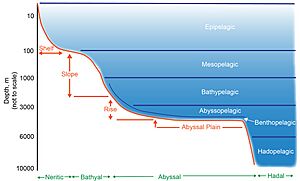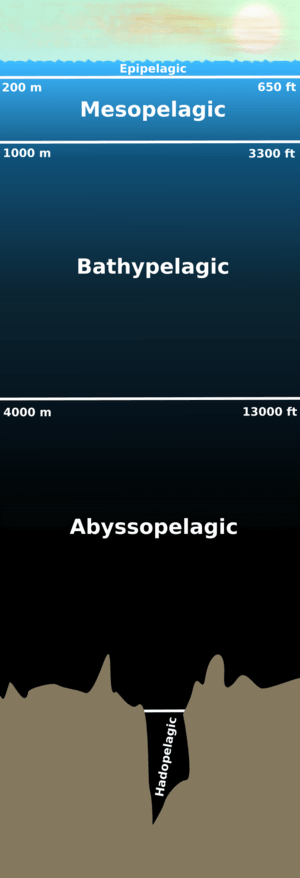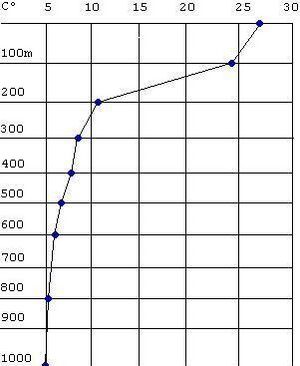Deep sea facts for kids
The deep sea is the part of the ocean where sunlight almost disappears. This usually happens around 200 meters (about 650 feet) deep. It's also where the flat continental shelf drops off into the steep continental slope. The deep sea is very cold, completely dark, and has incredibly high pressure. It's one of the least explored places on Earth because these extreme conditions make it very hard to visit and study.
Animals living in the deep sea have amazing ways to survive. They find food by scavenging (eating dead things), preying on other animals, or filtering tiny bits from the water. Many creatures eat "marine snow", which is organic material like dead plants and animals that falls from the sunlit waters above.
In 1960, a special submarine called the Trieste went to the very bottom of the Mariana Trench near Guam. This is the deepest known spot in any ocean, reaching 10,911 meters (about 6.8 miles) down. To imagine how deep that is, if Mount Everest (the world's tallest mountain) were placed there, its peak would still be more than 2 kilometers (1.2 miles) underwater! After the Trieste, a Japanese robot submarine called Kaikō could reach these depths, but it was lost in 2003. In 2009, another robot, Nereus, made several dives past 10,900 meters (6.8 miles) in the Challenger Deep.
Contents
Deep Sea Environment
Light
Sunlight cannot reach the deep ocean. Only the very top part of the deep sea, called the mesopelagic zone, gets a tiny bit of light. Because there's no light, photosynthesis (how plants make food using sunlight) is impossible. This means no plants or tiny ocean algae can grow there. Since these are the main food producers for most of Earth's ecosystems, deep-sea life must get its energy from other places.
Most of this energy comes from organic material that drifts down from the sunlit surface waters. This sinking material includes tiny bits of algae, dead plants, and animal waste. It's all called "marine snow".
Pressure
The pressure in the ocean increases a lot with depth. For every 10 meters (about 33 feet) you go down, the pressure goes up by about one atmosphere (the pressure we feel at sea level). This means deep-sea creatures live under extreme pressure. For a long time, scientists couldn't study these animals well because they would die or get damaged when brought to the surface.
Now, special traps with pressure-maintaining chambers allow scientists to bring up larger deep-sea animals alive and healthy. This helps us learn more about how they survive.
Salinity
The salinity (saltiness) of the deep sea is very steady, usually around 35 parts per thousand. There are only small differences, which don't really affect the animals, except in mostly closed seas like the Mediterranean and Red Sea.
Temperature
The ocean has two main areas where temperature changes a lot. One is the thermocline, which is the zone between the warm surface waters and the cold deep waters. Thermoclines can be from a few hundred to almost a thousand meters thick. Below the thermocline, the deep ocean water is very cold and stays almost the same temperature everywhere.
Thermoclines are strongest in tropical areas, where the surface water is usually above 20°C (68°F). As you go deeper, the temperature drops quickly to about 5-6°C (41-43°F) at 1,000 meters (3,300 feet). It continues to get colder towards the bottom, but much slower. This cold water comes from heavy surface water sinking in the polar regions.
The temperature at any given depth in the deep sea stays almost the same for very long periods. There are no seasonal changes and very little year-to-year change. No other habitat on Earth has such a constant temperature.
However, near hydrothermal vents (hot springs on the seafloor), the water coming out of "black smoker" chimneys can be as hot as 400°C (752°F)! The high pressure keeps it from boiling. But just a few meters away from these vents, the water temperature drops back down to 2-4°C (36-39°F).
Deep Sea Life
The ocean zones below the sunlit surface (epipelagic) are divided into more areas. The bathyal zone is from 200 to 3,000 meters (650 to 9,800 feet) deep. It's a transition area with features from both the shallower shelf and the deeper parts. Below this, the deep sea includes the abyssal zone (3 to 6 kilometers or 1.9 to 3.7 miles deep) and the hadal zone (6 to 11 kilometers or 3.7 to 6.8 miles deep).
Food is very scarce in the deep sea. It mostly consists of 'marine snow' and dead animals falling from above. This food is spread out and doesn't appear often.
Many deep-sea species don't use gas to float. Instead, they have jelly-like bodies made mostly of glycosaminoglycans, which are very light. Deep-water squid often combine this jelly-like tissue with a special chamber filled with a fluid made of ammonium chloride. This fluid is lighter than the surrounding seawater, helping them float.
Midwater fish have special ways to deal with these conditions. They are usually small, under 25 centimeters (10 inches). They have slow metabolisms and eat whatever they can find. They prefer to wait for food rather than waste energy searching. They have long bodies with weak muscles and skeletal structures. They often have jaws that can extend and hinge open, with teeth that curve backward. Because it's so dark and food is scarce, finding a mate is hard. Many organisms are hermaphroditic, meaning they have both male and female reproductive organs.
Since light is so rare, fish often have very large, tube-shaped eyes with only rod cells (which are good for seeing in dim light). Their eyes usually point upwards, helping them spot the silhouette of possible prey against the faint light from above. However, Prey fish also have ways to avoid being eaten. They often try to reduce their silhouette, which is a form of camouflage. Two main ways they do this are by having flat bodies (making their shadow smaller) and by using bioluminescence (producing their own light). They have light-producing organs called photophores on their undersides. These produce light that matches the dim light coming from above, making the fish almost invisible from below. For even better vision in low light, some fish have a retroreflector behind their retina, which helps them gather more light. Flashlight fish have this, plus photophores, which they use to spot the eyeshine of other fish.
Deep-sea organisms rely almost entirely on living and dead organic matter sinking from above, which falls at about 100 meters (330 feet) per day. Only about 1 to 3% of the food produced at the surface reaches the seabed, mostly as marine snow. This snow builds up on the seafloor very slowly, about 1 centimeter (0.4 inches) every 1,000 years. Larger food falls, like whale carcasses, also happen. Studies suggest these might happen more often than we thought. Many scavengers eat mainly or entirely from these large food falls. The distance between whale carcasses is thought to be only about 8 kilometers (5 miles). There are also many filter feeders, like Freyella elegans, that use tentacles to catch organic particles.
Tiny Marine bacteriophages (viruses that infect bacteria) are very important for recycling nutrients in deep-sea sediments. They are extremely common, with trillions found in every square meter of sediment around the world.
Even though deep-sea organisms are isolated, they have been harmed by human activities. The London Convention is an agreement that aims to protect the marine environment from dumping waste like sewage sludge and radioactive waste. One study found that deep-sea coral decreased in one area from 2007 to 2011. This was linked to global warming and ocean acidification, with biodiversity at its lowest in 58 years. Ocean acidification is especially bad for deep-sea corals because they are made of a fragile material called aragonite, which dissolves easily. They also grow very slowly, so it takes many years for them to recover. Deep-sea trawling (a type of fishing) also harms biodiversity by destroying deep-sea habitats that take years to form. Another human activity that has changed deep-sea life is mining. One study showed that fish populations decreased at a mining site for six months and then for three years. However, after 26 years, populations returned to their original levels.
Chemosynthesis
Some deep-sea species don't rely on food falling from above. These communities are found near hydrothermal vents on the seafloor, where hot water comes out of the Earth. A great example is the special relationship between the tube worm Riftia and chemosynthetic bacteria. These bacteria use chemicals from the vents to make food, a process called chemosynthesis. This process supports the amazing communities of animals found around hydrothermal vents. These are some of the only ecosystems on Earth that don't depend on sunlight for their energy.
Surviving High Pressure
Deep-sea fish have special adaptations in their bodies, proteins, and how their bodies work to survive the huge amount of hydrostatic pressure (pressure from water) in the deep sea. While finding food and avoiding predators are important, deep-sea organisms must be able to keep their bodies working well under high pressure. They have developed unique features to handle this extreme environment.
High pressure greatly affects proteins, which are essential for all life. Proteins can change how they fold and work under pressure. Deep-sea species have made changes to their proteins to keep them working correctly.
For example, actin is a protein vital for many cell functions, including muscle movement. Some deep-sea fish have developed pressure tolerance by changing their α-actin protein. In some species living deeper than 5 kilometers (3.1 miles), like C.armatus and C.yaquinae, specific changes in their α-actin help them tolerate pressure. These changes make the protein more stable, especially when it binds to ATP (energy molecules) and arranges its parts. Scientists found that deep-sea fish have more "salt bridges" (special bonds) in their actins compared to fish living in shallower waters.
Also, certain osmolytes (molecules that help cells balance water) are found in large amounts in deep-sea fish. For some cartilaginous fish (like sharks and rays), a molecule called Trimethylamine N-oxide (TMAO) increases with depth. TMAO helps protect proteins from being damaged by high pressure. This adjustment in osmolytes is a key way deep-sea fish survive high pressure.
Deep-sea organisms also have molecular adaptations for their bones. The Mariana hadal snailfish has a change in its osteocalcin gene, which controls bone development. This change seems to result in an open skull and bones made of cartilage. This is because a closed, hard skull, like those of animals on the surface, cannot withstand the constant high pressure in the deep sea. Similarly, normal bone structures seen in surface animals would break down under such pressure.
Exploring the Deep Sea
It's often said that we know more about the Moon than the deepest parts of the ocean. This idea comes from a statement made in 1953, and it mostly referred to how little we knew about the seafloor's shape back then. The similar idea that more people have walked on the Moon than have been to the deepest ocean is also not quite right and can be misleading.
Still, the deep sea remains one of the least explored places on Earth. Even at medium depths, the pressure becomes too great for traditional exploration. So, scientists use special methods for deep-sea research. These include baited camera stations (cameras with bait to attract animals), small submarines with crews, and remotely operated vehicles (ROVs). Because it's so difficult and expensive to explore this zone, our current knowledge is still limited. The pressure increases by about one atmosphere for every 10 meters (33 feet) of depth, meaning some deep-sea areas can have pressures over 1,000 atmospheres! This makes it very hard to reach these depths without special machines and also makes it tough to study the animals there, as their bodies are adapted to such extreme pressures.
See also
- Deep ocean water
- Submarine landslide
- The Blue Planet
- Blue Planet II
- Nepheloid layer
- Biogenous ooze




